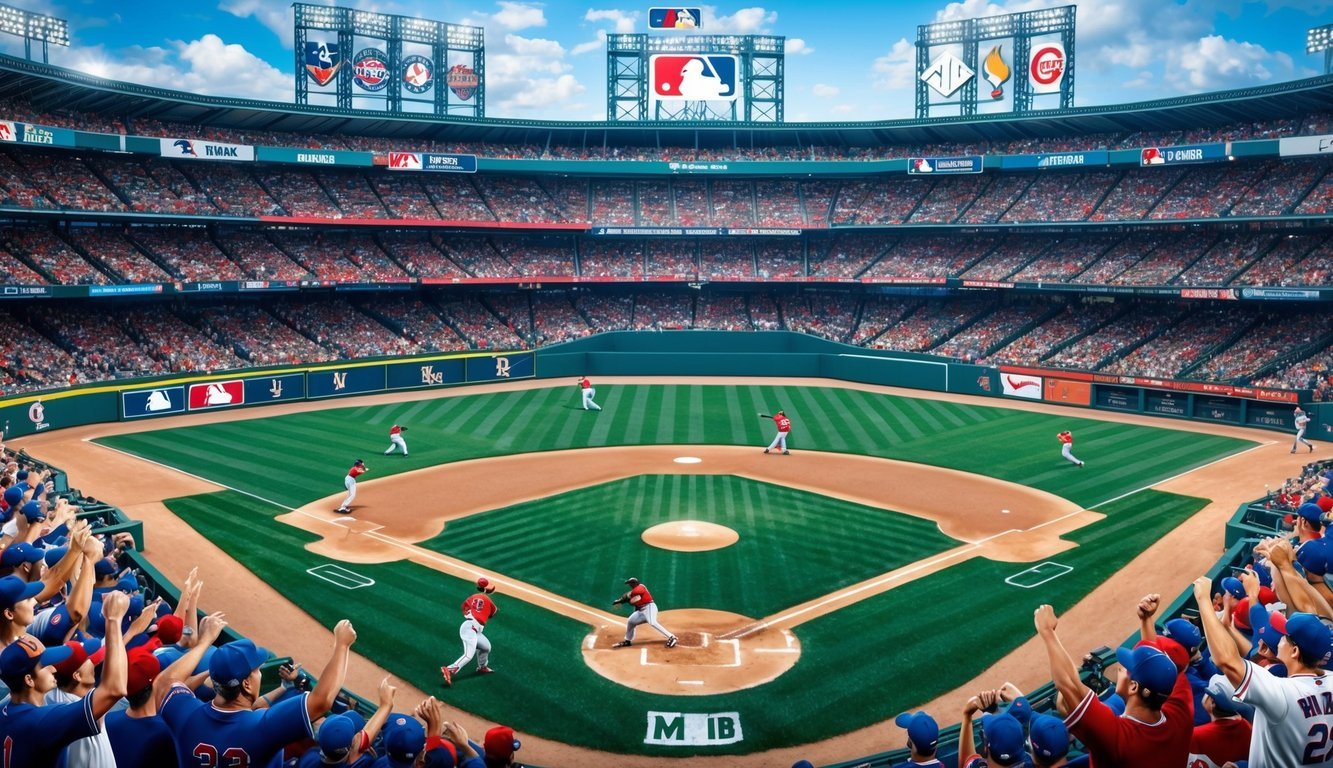As October approaches, baseball fans eagerly anticipate the MLB playoffs.
The postseason brings heightened excitement and drama as the best teams battle for World Series glory.
The MLB playoff format features 12 teams – six from each league – competing in a bracket-style tournament. The postseason expanded the format in 2022, providing more opportunities for teams to make a championship run.
The playoffs kick off with the Wild Card Series, where the lower-seeded teams face off in best-of-three matchups.
Winners advance to the Division Series against the top seeds, followed by the League Championship Series and ultimately the World Series.
With high stakes and intense competition, the MLB postseason captivates fans as it crowns baseball’s champion.
Structure of the MLB Postseason
The MLB playoffs follow a structured format that rewards top-performing teams while allowing more clubs to compete for the championship.
Seeds, byes, and home-field advantage play crucial roles in determining each team’s path to the World Series.
In addition to the competitive structure, teams must also navigate various challenges throughout the postseason, including potential delays due to inclement weather.
With unpredictable spring and fall conditions, MLB weather interruption strategies become essential in ensuring that games are played as scheduled, which can significantly impact a team’s momentum and preparation.
Ultimately, these elements combine to create an exciting and dynamic playoff atmosphere, where every game holds immense significance.
Overview of Playoff Format
The MLB postseason features 12 teams – six from each league.
Division winners secure the top three seeds, while three wild card teams round out the field.
The two best division winners in each league earn first-round byes, advancing directly to the Division Series.
Wild Card teams face off in best-of-three series to start the playoffs.
Winners move on to challenge the top seeds in the Division Series.
From there, the Championship Series and World Series decide the ultimate champion.
This expanded format, introduced in 2022, creates more excitement and opportunities for teams to make a postseason run.
Breaking Down the Rounds
Wild Card Series: Best-of-three matchups between the 3rd-6th seeds in each league.
Division Series: Best-of-five contests featuring wild card winners and top two seeds.
League Championship Series: Best-of-seven battles to crown American and National League champs.
World Series: The pinnacle of the postseason – a best-of-seven series to determine baseball’s champion.
Each round presents unique challenges and strategies as the stakes get higher and the competition intensifies.
Explaining Seeding and Home-Field Advantage
Seeding is based on regular season records, with division winners getting priority.
The team with the best record in each league claims the #1 seed and a first-round bye.
Home-field advantage follows seeding throughout the playoffs.
Higher seeds host more games in each series:
- Wild Card: Higher seed hosts all games
- Division Series: Higher seed hosts Games 1, 2, and 5
- LCS and World Series: Higher seed hosts Games 1, 2, 6, and 7
This format rewards regular season success and adds strategy to playoff matchups.
Teams fight hard for better seeding to secure more home games and easier paths to the championship.
Qualification and Seeding Criteria
The MLB playoffs feature a structured system for team qualification and seeding.
Division winners and top-performing teams compete for coveted postseason spots, with specific criteria determining their placement in the bracket.
Division and Wild Card Berths
Six teams from each league secure playoff berths.
The three division winners automatically qualify, earning the top three seeds based on their regular season records.
Three additional Wild Card teams round out the field, selected from the clubs with the best records among non-division winners.
This format ensures a mix of divisional champions and strong performers across the league.
Wild Card teams often come from highly competitive divisions, where multiple clubs post impressive records but can’t all claim the division title.
Determining Seed Ranks
Seeding plays a crucial role in the postseason structure.
The team with the best overall record in each league claims the No. 1 seed.
The remaining two division winners are ranked second and third based on their win-loss totals.
Wild Card teams occupy the fourth through sixth seeds.
Their regular season performance determines this order, with the team boasting the best record among Wild Card qualifiers securing the fourth seed.
Higher seeds enjoy home-field advantage in their series, a significant factor in playoff success.
Tiebreakers and Their Impact
When teams finish with identical records, tiebreakers come into play.
The primary tiebreaker is head-to-head record during the regular season.
If that’s even, the next step looks at each team’s record within their division.
For Wild Card spots, league record becomes the next tiebreaker if divisional records are tied.
In rare cases where all these factors are equal, interdivision records may be used to break the deadlock.
Tiebreakers eliminate the need for extra games to determine playoff spots, streamlining the transition from regular season to postseason play.
Progression Through the Playoffs

The MLB playoffs follow a structured path from the Division Series to the ultimate showdown in the World Series.
Teams face increasing challenges as they advance, with longer series and tougher competition at each stage.
From Division Series to League Championship
The Division Series kicks off the main playoff bracket.
It’s a best-of-five series, giving teams multiple chances to prove their mettle.
The higher-seeded team gets home-field advantage, hosting three games if necessary.
Winners move on to the League Championship Series (LCS).
This best-of-seven battle determines each league’s pennant winner.
The LCS ramps up the intensity, often producing memorable moments and heroic performances.
Teams need to win four games to claim the pennant.
Home-field advantage again goes to the higher seed.
The series follows a 2-3-2 format, with the first two and last two games (if needed) at the higher seed’s ballpark.
The Pinnacle: The World Series
The World Series is baseball’s grand finale.
It pits the American League champion against the National League champion in a best-of-seven showdown.
This is where legends are made and dreams come true.
Home-field advantage in the World Series alternates between leagues each year.
The 2-3-2 format continues here, creating a unique atmosphere as the series shifts between cities.
Teams must win four games to be crowned World Series champions.
The victors earn the coveted Commissioner’s Trophy and the right to call themselves baseball’s best.
Players receive championship rings, cementing their place in MLB history.
Key Modifications in Recent Seasons

Major League Baseball has revamped its playoff structure in recent years, expanding the field and introducing strategic changes.
These updates have significantly altered how teams approach the postseason.
Expansion of Teams and Format Changes
In 2022, MLB expanded the playoff field to 12 teams, up from 10 in previous seasons.
This change allowed six teams from each league to compete for the World Series title.
The new format introduced first-round byes for the top two division winners in each league.
The Wild Card round now features best-of-three series.
This replaced the previous single-game elimination format.
Division winners who don’t receive byes are now seeded third and face the lowest-seeded Wild Card team.
Higher-seeded teams host all games in the Wild Card round.
This gives a distinct advantage to teams with better regular-season records.
Strategic Decisions Under the New System
Teams now face different considerations when building their rosters.
The expanded format places greater emphasis on regular-season performance to secure higher seeds.
Managers must carefully plan pitching rotations.
With potential for longer series, depth becomes crucial.
Teams with strong bullpens may have an edge in the new format.
Rest versus rust debates have intensified.
Teams earning byes get time off, but may face well-tuned opponents coming off Wild Card victories.
Front offices now weigh trade deadline decisions differently.
More teams remain in contention later into the season, potentially affecting player movement and roster strategies.
Historical Context and Memorable Moments

The MLB playoffs have given fans countless thrilling moments and unforgettable championships over the years.
From legendary teams to iconic players, the postseason has shaped baseball history and created lasting memories for generations of fans.
Notable Championships and Series
The 2011 playoffs stand out as one of the most exciting in MLB history.
The St. Louis Cardinals made an incredible late-season comeback to clinch a Wild Card spot on the final day.
They went on to win a thrilling World Series against the Texas Rangers in seven games.
The 2004 ALCS saw the Boston Red Sox make an unprecedented comeback from a 3-0 series deficit against the New York Yankees.
This historic run led to Boston’s first World Series title in 86 years, breaking the infamous “Curse of the Bambino.”
In 1993, Joe Carter’s walk-off home run in Game 6 clinched the World Series for the Toronto Blue Jays against the Philadelphia Phillies.
This dramatic moment remains one of the most iconic in playoff history.
Impactful Teams and Players
The New York Yankees dynasty of the late 1990s and early 2000s dominated the postseason.
Derek Jeter, Mariano Rivera, and Jorge Posada led the team to four World Series titles in five years from 1996 to 2000.
The Atlanta Braves’ run of 14 consecutive division titles from 1991 to 2005 showcased remarkable consistency.
During this stretch, they only won one World Series, but their sustained success left a lasting impact on the sport.
Individual playoff performances have also etched themselves in baseball lore.
Madison Bumgarner’s superhuman effort in the 2014 World Series for the San Francisco Giants included a five-inning save in Game 7 on just two days’ rest.
Reggie Jackson earned the nickname “Mr. October” for his clutch postseason hitting, most notably smashing three home runs in Game 6 of the 1977 World Series for the Yankees.
